Midnight in Paris
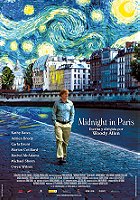 Posted : 13 years, 6 months ago on 22 December 2011 05:32
(A review of Midnight in Paris)
Posted : 13 years, 6 months ago on 22 December 2011 05:32
(A review of Midnight in Paris)The incredibly well-acted ensemble cast sees Owen Wilson as the head of the cast, it’s his aspiring writer who wanders off into the past and allows for the magical realism to take place. There is no logic, no reason given as to why or how these events are able to happen. And the film is actually all the better for that. To give a reason as to why this modern screenwriter with daydreams of becoming a good novelist who expatriated to Paris meets these titans of the artistic, film, and literary worlds would doom it to literal-minded science-fiction. Think of this as a spiritual cousin to Purple Rose of Cairo.
Wilson really surprised me. I had all but given up on him as an actor, believing that the days of The Royal Tenenbaums long behind him. That he had given up trying to find more challenging, artistic material and had instead decided to coast on his innate likeability to star in a long succession of brain-dead comedies and inert rom-coms. But here he seems engaged, enthusiastic about the material and the character that he just helps to sweep you up in the film. (The less said about the roles Rachel McAdams, Kurt Fuller, Mimi Kennedy, and Michael Sheen are stuck with the better. Allen’s penchant for creating god-awful elitist, pseudo-bourgeois upper class monstrosities rears its ugly head once for them. They play their roles well, and are thankfully are small portion of the movie.)
But the true reason to see the film is the parade of towering figureheads from the 1920s – Hemingway, Buñuel, the Fitzgeralds, Picasso, Stein, and so on. And while they are represented as quick sketches of their most defining traits, Hemingway speaks in formal but hyper-masculine prose for example, they are all highly entertaining. Adrien Brody’s cameo as Salvador Dalí lingers in the imagination because of his humor and grace in the small cameo. And Marion Cotillard as Adriana cements her reputation as both one of the greatest working actresses, and one of the few actresses who took her Oscar win as a chance to not coast on easy roles, but to find unique material to work with. She, as always, is master of subtlety and grace in her role, projecting warmth and sensuality in equal measure.
Woody Allen, as far as I am concerned, is an artistic treasure. Even if I don’t like his films, I’m happy to have seen them simply because it means that he is still working outside of the studio system to follow his muse and creating his own unique stories. I’m unsure if Midnight in Paris will go down as one of his best. All I know is that I felt like he had created a movie specifically for me. Thank you Mr. Allen.
 0 comments, Reply to this entry
0 comments, Reply to this entry
Silver Surfer
 Posted : 13 years, 6 months ago on 16 December 2011 05:47
(A review of Silver Surfer)
Posted : 13 years, 6 months ago on 16 December 2011 05:47
(A review of Silver Surfer)It does, however, frequently achieve greatness in its stylized animation, and the way in which traditional animated elements and computer-generated ones blend nicely. (The two animation styles are never seamlessly blended but the effect holds up spectacularly well considering this was a Saturday morning cartoon airing in 1998.) There are moments when the animation looks so much like a Jack Kirby comic come to vivid life that the most hardcore of comic book nerds will want to rewatch certain segments with the sound off to just enjoy their beauty.
However, given Marvel’s financial troubles lurking just around the corner, there are also moments when the animation dips into crappy motion-comic territory. Oddly enough, whenever Galactus and Silver Surfer occupy the frame the animation is always of the highest quality. The problem comes in whenever Nova, Beta Ray Bill, Adam Warlock, and other guest stars make their appearances. For some reason the animation on these characters is lacking. Thanos is also devoid of weight, menace or grit, which really hinders the show as a whole since he’s set-up as the overarching nemesis for the series.
But it’s still refreshing, quite pleasing really, to revisit an old show and realize that the reason who truly liked it still holds up much of the time. The writing on this show never shies away from the Surfer’s existential quandaries, or the human weakness beneath the demigod surface. He seeks not just his home world, but a spiritual awakening and inner peace which offers up much time for quiet, meditative scenes of the Surfer narrating his inner monologue and flying through space (look for a planet that looks suspiciously like Apokalypse). A show like this would never get made nowadays. It waits too much, and doesn’t pander the character’s psychology to the grade-school set. Flaws and all, Silver Surfer is worth a watch just to witness a superhero cartoon that has it’s character question his purpose, his god-like power, and where he fits in the grand cosmos.
 0 comments, Reply to this entry
0 comments, Reply to this entry
Batman: Gotham Knight
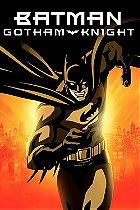 Posted : 13 years, 6 months ago on 12 December 2011 05:04
(A review of Batman: Gotham Knight)
Posted : 13 years, 6 months ago on 12 December 2011 05:04
(A review of Batman: Gotham Knight)Let’s begin.
Have I Got a Story For You
For anyone who’s seen “Legends of the Dark Knight” in Batman: The Animated Series, this story feels completely redundant, right down to the types of characters that the kids represent. While it may not add anything new, narratively speaking, to the formula of that episode, it does provide some interesting visuals.
Generally, this is the weakest short in the set, and much of that has to do with the stylization of the animation. While it is continually fluid, there’s a certain crudeness and unappealing anemic quality to each character’s physique. None of them look like a natural human being, arms and legs bend in places they shouldn’t and there doesn’t seem to be a consistent musculature to any of them.
Scenes in which Batman appears as an amorphous vampire who can turn into a silver puddle and then manifest himself whole at will and as a demonic humanoid bat-creature are joys. It’s a pity that they add up to nothing by the time it ends.
Crossfire
Crossfire sees two partners taking a captured criminal back to the Narrows. While completing this task they argue over the nature of Batman and his impact/presence on Gotham’s demimonde. It’s more interesting for portraying two cops getting into a philosophical argument about Batman – the man, the icon, the hero, the symbol.
Batman never really appears in this short, his screentime being limited to a silhouette at the beginning and a very real presence after the gang warfare erupts and captures the two officers in the, yep, crossfire. Limited screentime aside, Batman’s felt throughout thanks to the debate about his effectiveness. It reminded me of “A Bullet for Bullock,” a noir revenge story in which a morally dubious cop must ask Batman, a man he considers to be just as bad as the scum he brings to justice, for help.
Field Test
One of the odd things about anime is the way in which dreamy, hunky boys are drawn as androgynous, long-haired, glassy eyed twinks. And here we get to glimpse a Bruce Wayne who looks an awful lot like Zac Efron.
The storyline features Lucius Fox creating a device which will deflect bullets off of Batman. While using it during a gang war between The Russian and Sal Maroni, a bullet deflects off of Batman and grazes into a henchman. A distressed Batman rushes him to the hospital, and politely gives the device back to Fox saying that he’s willing to sacrifice his own life but not anyone else’s. It’s decent, but never really achieves greatness.
In Darkness Dwells
So far, none of the shorts have featured any of the more colorful villains in Batman’s rogues gallery. We’ve been regulated to gangsters and turf-wars, which are fun in small doses but grow tedious after three consecutive films.
In Darkness Dwells features both Killer Croc and the Scarecrow. And thank God that we’ve finally been treated to some costumed villainy for Batman to fight. Dwells is the most overtly noir of all of the shorts, and the better for it. From the severe angles to the gaunt shadows and reliance on sickly yellows and browns, Dwells looks like a Batman cartoon as imagined by Orson Welles circa-The Lady from Shanghai or Touch of Evil.
The plot could have taken a backseat to the visual feast, the first truly beautiful and arresting one in the bunch, but it adds a further layer or pulpy goodness. The dialog recalls the best of Hammett, or even Frank Miller’s work on Batman: Year One and Sin City. If it weren’t for the next film, this would easily be my favorite.
Working Through the Pain
One of the great joys of Batman is that he is mortal. There’s a perverse pleasure in seeing damaged, obsessed hero being made to bleed. His vulnerability makes him relatable and unique in a way that other heroes like Wolverine or Superman can never hope to achieve with their invincibility. Batman’s also animated in a more slender form, making this feel like a true early-years story.
Working Through the Pain sees Batman having been shot and struggling to climb his way out the sewers alive. In-between setbacks, conversations with Alfred, and performing first aid on himself, we sees flashbacks to Bruce Wayne training in India to, you guessed it, work through the pain.
It’s an astonishing work from top to bottom. Batman: Gotham Knight takes a while to get going, but by the time we reach the last three films it’s finally started cooking. Pain is easily the best, for a variety of reasons. The animation is beautiful, the voice work is great, but it’s the story that really allows this one to soar. It’s an untold story, and it provides a great access point to the man and the myth behind the cowl.
Deadshot
Deadshot explores the symbiotic and perverse relationship in which the very things that spawned Batman, and his obsessive and single-minded mission, can also create the very enemies which infect his city. As Bruce explains, the seductive power of a gun repulses and fascinates him, but our villain for this piece is Deadshot, a villain who sees nothing but simplicity, artistry, and beauty in the destructive power of a gun.
It’s a stellar ending to the omnibus, but it offers nothing truly new to the animated legacy of Batman. After Batman: The Animated Series, everything seems cute and quaint by comparison. The intelligence with which the writers and animators delved into the psyches of their characters and turned up surprising and moving images and bits of dialog in a supposed children’s cartoon remain unparalleled, especially since Gotham Knight feels like retreads of episodes of B:TAS given freer reign and the ability to swear and show blood.
 0 comments, Reply to this entry
0 comments, Reply to this entry
Tangled
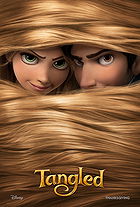 Posted : 13 years, 6 months ago on 12 December 2011 04:59
(A review of Tangled)
Posted : 13 years, 6 months ago on 12 December 2011 04:59
(A review of Tangled)What’s most refreshing about Tangled is how it puts the lie to the irony-laced, increasingly under-cooked, and artistically painted-in-a-corner entertainments like the Shrek franchise. Here is something that embraces its good-natured fairy tale origins, and finds poetic visuals and moments of true splendor in rendering them.
The scene where Rapunzel, after being held captive for most of her life, discovers the outside world is both hilarious and moving. The reaction shots of her character oscillating wildly between “Yippee!” and “I need to be punished!” are a perfect depiction of one’s teenage years. But it’s the way in which her character discovers the breeze, the feel of the grass beneath her feet, and the way cool water feels on her hand that is a quiet and artistically powerful way to depict the awakening of her senses, awareness, and ascent into adulthood.
Or the scene in which she sees thousands of lanterns being released into the air on her birthday. Which is breathtaking in its beauty, and joyous in its emotional uplift. It’s practically otherworldly in the way that it engulfs you. Behold, the power that only movies, and in this case animation, can provide.
And while Alan Menken, always a welcome presence in my mind in any Disney project, churns out serviceable songs, none of them truly stick. They touch you, mesmerize you, and greatly move the story along, but none of them are as memorable as “Under the Sea,” “Be Our Guest,” or “Out There.” Mandy Moore’s thin voice may be part of the problem, but even Donna Murphy’s diva-licious villain doesn’t linger in the imagination much.
It’s really the humor that lingers. All of the truly great Disney movies rely upon effective villains and sidekicks, be they good or bad. Tangled has memorable animal sidekicks, but our villain isn’t ever truly evil in the same pleasing way as Ursula or Maleficent, just passive-aggressive, abusive, and narcissistic. Where's the grand-scale plan? Stephen Sondheim's tormented and contradictory Witch in Into the Woods hints at what could have been with this character. Alas, it was not to be. But back to those sidekicks for a minute, the chameleon and horse in particular. Many of the best gags, including a reoccurring one relating to frying pans, either are started or continuously brought about by their presence.
Much like The Princess and the Frog, Tangled returns us to a happier time when animation was driven by warmth, humor, characters, and stories. This deliberate rejection of post-modernist conventions actually makes this feel like a breath of fresh air. Now, if only we could return to hand-drawn animation.
 0 comments, Reply to this entry
0 comments, Reply to this entry
Justice League of America
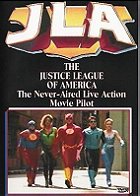 Posted : 13 years, 6 months ago on 12 December 2011 04:11
(A review of Justice League of America)
Posted : 13 years, 6 months ago on 12 December 2011 04:11
(A review of Justice League of America)Everything you could imagine that could go wrong with a live-action TV series based from this material, well, it went wrong. So very, very wrong.
Where to begin to describe this film’s awfulness?
I have decided to make an unnumbered list:
• I know that WB has an ‘embargo’ on various characters to stop cross-pollination, but this is the best that they could muster up for the live-action JLA? Obvious second-stringers like Flash, Green Lantern, the Atom, and Martian Manhunter make the cut, but schlock like Fire and Ice? They should have been cameos at best. No shade was meant against the likes of Flash and Green Lantern, but they're not on the same level of heavy-hitters like Superman, Batman and Wonder Woman.
• Focusing the entire film on Ice discovering her powers, joining the team, and figuring out that her boss is the Weatherman is a poor decision for a variety of reasons, but it’s mainly because the actress playing her is awful.
• They decided to make the JLA do confessionals…in their real world/everyday counterparts.
• Fire’s costume consists of her lathering on green makeup around her eyes and on her cheeks to hide her identity. That no one mentions that this is not a proper disguise next to the full face masks of the Atom and the Flash is anyone’s guess.
• The members of the JLA are now Friends-style Gen Xer’s trying to make a go of things in the mid-90s. What does that mean? The Flash is now an unemployed slacker; they all get together regularly to complain about First World problems and their romantic lives; and it just goes on from there.
• The costumes look like they were made for a low-rent high school production of some bizarre superhero-focused play. (Which, let's be honest, that would be far more entertaining to watch.)
• Why did they cast actors who look so incredibly out-of-shape as superheroes? The bulky costumes do not help the situation.
• The special effects are truly something to behold. I’ve seen other TV movies from around this time produce greater work. Hell, Xena and Hercules churned out better effects work on their low-budgets than this piece of crap.
• It occupies a space right next to Catwoman, Howard the Duck, Batman & Robin, and Tank Girl as truly awful adaptations of comic-book properties.
I think that covers just about everything wrong with this failed pilot. But, if you’re interested in watching it for yourself, I'm sure it's readily available somewhere on the vast resources of the internet.
 0 comments, Reply to this entry
0 comments, Reply to this entry
Ultimate Avengers 2: Rise of the Panther
 Posted : 13 years, 6 months ago on 8 December 2011 05:05
(A review of Ultimate Avengers 2)
Posted : 13 years, 6 months ago on 8 December 2011 05:05
(A review of Ultimate Avengers 2)Once more the only character that gets any true character development is Captain America. This time around he’s undertaking suicide-friendly missions in an effort to feel alive and reclaim his manhood. It makes perfect sense that the world’s super soldier would react to his new life by trying to desperately reclaim his masculinity and get a strangle-hold on his lone field of experience. What else is he good for in an era that is completely different from his, and a time in his life when he no longer knows anybody. He’s thrown himself head-long into a world that he does know.
But Thor, Hulk, Wasp, and Giant-Man are thrown off to the sides, regulated to occupy sub-plots B, C, and D. The Hulk’s regulation to glorified cameo is especially disheartening since this incarnation of him is so much more disturbed, driven, and really exploratory of the Jekyll/Hyde dynamic at the radioactive-id’s core.
But what of the Black Panther, who gets his introduction in this film? Well, his origin follows fairly closely to the one that any good comic fan knows. But, for some odd reason which is given no explanation, his head can turn into a literal panther’s from time-to-time. His new costume leaves something to be desired (don’t let the cover art fool you). He doesn’t do much, despite being the sub-title’s main topic, and just occupies the biggest subplot without very truly being developed or explored.
So much of Ultimate Avengers 2 had potential, but instead of taking their time and really building up and expanding the storylines and character development with the sequel, the folks at the Marvel Animation department just cranked out a sequel within months of the first film’s release. It could have been so much more.
 0 comments, Reply to this entry
0 comments, Reply to this entry
Cowboys & Aliens
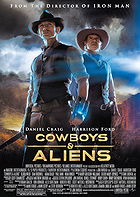 Posted : 13 years, 6 months ago on 8 December 2011 05:04
(A review of Cowboys & Aliens)
Posted : 13 years, 6 months ago on 8 December 2011 05:04
(A review of Cowboys & Aliens)“What went wrong?”
“How did something that sounded like a brain-dead, but awesomely rollicking and supremely fun thrill-ride turn out so fucking boring?”
These were but a few of the thoughts that crossed my mind as Cowboys & Aliens lethargically played out before my eyes. Not a single happens in this film that could be described as shocking, surprising or interesting. It plays out exactly as one would think from the trailer and TV spots. It’s ripe with clichés about bitter old racists overcoming their ignorant beliefs, mysterious women being exactly the barrier of information and hope that the main character(s) needed, and a Man With No Name/Memory finding the key to his identity.
The Old West town in this film looks like something filmed on the Universal Studios back-lot, with location shooting done in the same places that John Ford/Wayne put on the cinematic map to much better effect forever ago. It tries desperately to adhere to genre conventions, but never truly gets the spirit or tone right. It is pure pastiche without any of the weight or simple poetry of the truly great westerns like High Noon.
This false note is echoed in each of the performances. The actors appear to be happy to tag along for this ride, but none of them deliver a true performance. Each of them appear too clean, too modern, too much like actor’s playing pretend in period get-up. The worst of which is Olivia Wilde who mostly stares with her wide-eyes and has a cringe-worthy accent that sounds like she’s straining to maintain it throughout.
The title does dip into false advertising for much of the time, with the film being primarily a western with the slightest taste of science-fiction for much of its running time until the last third. But the motivations for the aliens are as moronically underdeveloped as the rest of the characters and their situation. They’ve come to Earth to harvest gold. And for what purpose? Is it their monetary standard, or do they find it to be as arbitrarily valuable as we do? Your guess is as good as mine. And why are they kidnapping aliens? To perform experiments on the native species to determine its weaknesses, I didn’t know it would take an advanced alien race so many different specimens to figure out what our weaknesses. Perhaps this alien race has a market for human-torture porn.
The design of these alien creatures is both a retread of something that we’ve seen before and incredibly stupid. You see, they look like the upright cousin of the xenomorph from the Alien franchise. But they have one difference – their chests open up to reveal a smaller set of arms and their beating heart. In order to kill them, all you’d have to do is wait for them to open their chest, reach their second arms out, and stab at their beating heart. It’s a glaringly obvious weakness in their design/anatomy.
But this inattention to detail in just about every sector of the film should come as no surprise. No one went into Cowboys & Aliens expecting high-art or scenes of serious contemplation, but a pulpy good-time with inventive action scenes and thrills would have been nice. These two tones could have made sweet music, but the jarring shifts in tone are leaden and limp.
 0 comments, Reply to this entry
0 comments, Reply to this entry
Robin Hood
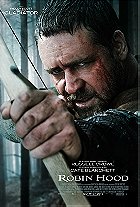 Posted : 13 years, 6 months ago on 8 December 2011 05:03
(A review of Robin Hood)
Posted : 13 years, 6 months ago on 8 December 2011 05:03
(A review of Robin Hood)But it didn’t have to be this way. Robin Hood started life as a spec-script called Nottingham in which we are treated to a sympathetic sheriff as our heroic figure. He would have been emotionally torn between following a king who was corrupt and dipping into madness on one hand, and on the other would have had a vigilante running amok in the wilderness. It sounded like a clever, unique, and engaging reexamination of an oft-told tale. So, naturally, what we got was another version of the familiar.
Perhaps if Ridley Scott hadn’t tried to treat a myth, something he tackled so well in Legend’s directors cut, as a starting ground for historical accuracy and period-perfect detail we would have had something special. Instead, we’re given something that looks detailed and beautiful on the screen, but in its storytelling and heart is hollow and dull. And its revisionist slant on true history offers up no favors. It can’t get the myth right, or the actual history, so why treat it all so painfully serious?
Little is asked of the actors, but they try to create in this bore. It’s a triumph of cinematography, art direction and costuming. Otherwise, it’s a listless affair that just makes one long for the innocence and joyous joie de vive that Errol Flynn’s take on the character so perfectly captured. A myth is a myth, and trying to graft onto it anything of serious historical document or examination is going to make it collapse in on itself.
 0 comments, Reply to this entry
0 comments, Reply to this entry
Elmer Gantry
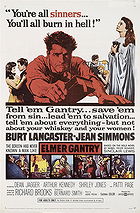 Posted : 13 years, 6 months ago on 28 November 2011 04:02
(A review of Elmer Gantry (1960))
Posted : 13 years, 6 months ago on 28 November 2011 04:02
(A review of Elmer Gantry (1960))While nothing ever seems to turn to synthetic cheese quite as quickly as Hollywood’s idea of “edgy,” Elmer Gantry retains much of its bitter taste after all these years. Could it be that in the time since its release the evangelical movement hasn’t just grown, but has shown to be a breeding ground for the morally bankrupt to trade-in on those seeking spiritual enlightenment through quick fixes and cash? You’d be absolutely correct. Think of every great scandal to rock a evangelical preacher – sex, drugs, booze, stealing, the list goes on. Elmer Gantry discussed the rot at its core long before men like Ted Haggard or Jim Bakker were rocking the news and tabloids.
Burt Lancaster, an actor who always thrust his whole body into a performance, had a real gift for playing the unscrupulous and con-men. Think of his work in Sweet Smell of Success or The Rainmaker. As the titular character, Lancaster deservedly won an Oscar. He lays the charm on so thick that we almost buy the bullshit that he’s peddling to everybody else. He makes Gantry less of a person than a powerful locomotive in the guise of a human. Trying to watch anyone else on screen while he is in the frame is an almost Herculean task.
While Jean Simmons as Sister Sharon Falconer turns in a complicated and much quieter character study. She creates a character that is consistently possessed by religious zeal. For her, this is no quick way to make money. This is a calling, and she is a prophet from on the mount who is actively seeking God’s graces and wisdom, and to share these gifts with her flock. Lust for Gantry becomes a religious movement, and she turns it inward and uses this emotion to help cement her self-immolation and self-divined sainthood. It’s an extraordinary piece of work that holds up nicely against Lancaster’s career defining work.
The real surprise of the entire acting ensemble though is Shirley Jones as the pastor’s daughter-turned-hooker because of her past relationship with Lancaster. I’ve known her primarily as Mrs. Partridge, and to see her so effectively play such a vicious and cold-blooded dramatic part was a true shock. Her steely-eyed look as she plays with hosiery is as enrapturing as her delivery of a monologue about how Gantry was the reason for her fall into disrepute. The way she lands the innuendo-laden "rammed the fear of God into me" is laced with acid even if she's laughing merrily along the way.
Elmer Gantry is limited from true greatness by director Richard Brooks’ occasionally flat eye. For every great shot, Simmons in near erotic passion while surrounded by flames or Jones’ disinterested fiddling with her hosiery, there’s long stretches where the camera feels too planted. Elmer Gantry is a punishingly long film, two-and-a-half hours, and the pacing often dips into a drag or self-righteous screed.
It sure does have sharp teeth, I will grant it that. A bulk of the film is about the ways that these three people con, love, fight, and forgive each other. Gantry’s a bull in a china shop, Sister Falconer’s a true believer, Lulu’s a scorned lover that’s pure flash, and we come to understand them as the movie goes on. While it may not be a first-rate classic, it is something of a minor one.
 0 comments, Reply to this entry
0 comments, Reply to this entry
Dark Passage
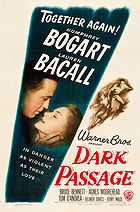 Posted : 13 years, 6 months ago on 28 November 2011 04:01
(A review of Dark Passage (1947))
Posted : 13 years, 6 months ago on 28 November 2011 04:01
(A review of Dark Passage (1947))After the runaway success of their previous pairings, To Have and Have Not and The Big Sleep, one couldn’t blame Warner Brothers for wanting to rush out something else starring the real-life couple. And Dark Passage has a sufficiently pot boiler of a noir script: Bogart plays a man who has recently escaped from prison, on the run from the law and looking for anyone to help him out on his quest to clear his wrongly accused name, he runs into Bacall, tough and independent as ever. The plot does dip into moments of strained credibility quite frequently, but the odd assortment of supporting players keeps it consistently engaging.
The first third of the film is filmed in first-person. It’s an interesting technique to approach the subject matter with, but the visual trickery is never completely successful. It always possesses the aura of the filmmakers trying to show off rather a vital and necessary tool for telling the story. Either that, or Bogart insisted on having a relatively short amount of time on-set since he doesn’t show his face until the final third. The second act sees his character undergo plastic surgery to elude the police and the conspiracy surrounding him. We’re treated to a mute, bandaged character for a substantial amount of time. The big reveal doesn’t pack much punch, but it’s nice to finally see the charisma and anti-heroic magnetism in Bogart’s face.
San Francisco is always a welcome site in a noir film, and the gothic architecture and mist-soaked atmospherics help bolster the film’s problematic execution. Dark Passage is enjoyable, and a watchable diversion, but it never reaches the heights of The Big Sleep (a classic and great example of the Bogie-Bacall pairing) or The Maltese Falcon (another classic and a great example of a San Francisco-based noir). It dips and drags, but it’s never truly awful.
 0 comments, Reply to this entry
0 comments, Reply to this entry
 Login
Login
 Home
Home 95 Lists
95 Lists 1531 Reviews
1531 Reviews Collections
Collections